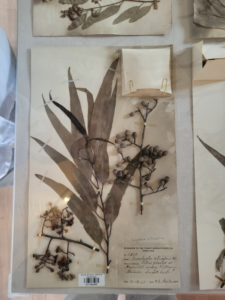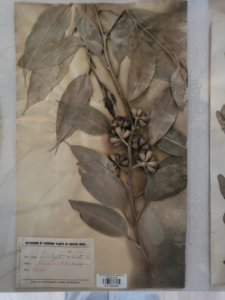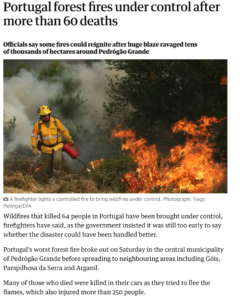Programme guide: Plant hunters
Specific tree species: Eucalyptus
The eucalyptus tree is native to Australia and spread around the world after being plundered by the British. He is the fastest growing and tallest hardwood and in India, from the 1840s onwards, it became the most common tree species in botanical gardens. A very interesting phenomenon is that blue smoke can often be seen in dense areas of eucalyptus in botanical gardens, due to the combination of eucalyptus oil with dust particles and water vapour, scattering short wavelengths of predominantly blue light”.
To humans, the eucalyptus tree may be a flowering tree, but in nature, in its struggle to survive and evolve, the eucalyptus tree’s survival strategy is to become its own ‘royal’ invader, killing 10,000 enemies and destroying 8,000.
Eucalyptus has a large number of volatile substances and many derivatives, including essential oils, so it is easy to see that eucalyptus is oily, but its oil is mainly concentrated in the leaves, which are also generally smaller to reduce the temperature of water loss at high temperatures, so it ignites more easily than other woods (above 40°C constitutes a condition for spontaneous combustion), burns faster (less damage to itself) and spreads more easily with the wind. In addition, the branches of eucalyptus trees mostly grow at the top of the tree, so that in the event of a fire the leaves are not too thick and the trunk is not easily destroyed by direct flames. But eucalypts are also prepared for fire in two ways. The nutrient pipeline of eucalypts has evolved from the bark to the heart of the tree, and large numbers of eucalypts survive fires, whereas most other tree species would die extensively in a fire. In addition, some dormant branches in the bark of eucalyptus trees will awaken after a fire.
Eucalyptus appears as a cash crop in human daily life: essential oils, toothpaste, paper, gardening, interior design. It has leaves, trunk and roots from which humans can extract the appropriate raw materials.


The global spread of eucalyptus trees has led to devastating effects such as falling water tables and increased fire risk.
“What happens when these trees are removed from the indigenous areas where they grow and the traditional custodians who tend them?”
1. As a fast-growing timber, it was heavily promoted worldwide, both as a cash crop and for landscaping work. The British encouraged its cultivation in their colonies, although the ecology was very different. (India)
Eucalyptus has recently been introduced into swampy and malarial areas where it acts as an air purifier and repels the deadly miasma.
At the same time, the British used paper made from eucalyptus for political propaganda.
(New democracy’s eucalyptus purifies the political quagmire)

2. In June 2017, a major forest fire in the Greater Pedrogão Mountains of Portugal killed 62 people and injured more than 250.

It is true that mountain fires occur in Portugal every year and the country itself has a great deal of experience in dealing with forest fires. In the aftermath, however, those familiar with the development of forestry in Portugal blamed the disaster on the rapidly expanding eucalyptus plantation industry.
Prior to this, Portugal grew mainly oak (the bark of which was used for cork), which accounted for 50% of the world’s exports. However, as oak could only be used for stoppers for containers (e.g. cork for boiling water bottles), cushioning materials, special shoe materials, models, badminton heads, etc., there was less scope for market growth compared to eucalyptus.
As a result, Portugal has been promoting eucalyptus plantations, which have reached 700,000 hectares in 2015, which eventually led to tragedy.
3. The expansion of eucalyptus is now also taking place in southern China, where it is known as “fast-growing eucalyptus” (originating from Australia and known in some parts of China as “livestock eucalyptus”)

Approved by the Department of Natural Resources of Guangdong Province. / Screenshot from the official website
A 2018 CCTV report showed that after planting eucalyptus trees, the fertility of the land declines and even dries up, making it impossible to plant again; peanuts growing in eucalyptus forests produce black oil when fried, and sugar cane near eucalyptus trees is bitter.
Despite this, eucalyptus is still grown in 18 provinces in China to expand economic income.
Behind this, in addition to the eucalyptus’ own survival advantages (easy growth and fast maturity), there is a push from large international paper conglomerates such as Daio Paper in Japan and the Golden Light Group in Indonesia, most of which have long-term supply and marketing agreements with a number of rural cooperatives in southern China.
In general, eucalypts have rapidly climbed to the top of the ecological chain by constantly mutating, occupying survival territories and crowding out other species, and then increasing the fertility of the land through the power of fire.
Humans see the effort and value of eucalypts, but in a way they also become victims of the economic value they create.
Reference:
Stanturf, John A., et al. “Eucalyptus beyond its native range: environmental issues in exotic bioenergy plantations.” International Journal of Forestry Research 2013 (2013).
Shipping Roots https://www.rbge.org.uk/whats-on/climate-house-presents/shipping-roots/
Directions:
1. How did the British use eucalyptus to spread colonialist ideas? In terms of art, posters?
2. the impact of eucalyptus in non-originating areas after it was taken away by the colonisers?
3. its place in the passive migration of eucalyptus? The eucalyptus was an object of plunder, but in essence it was also an imperialist aggressor that plundered others.

